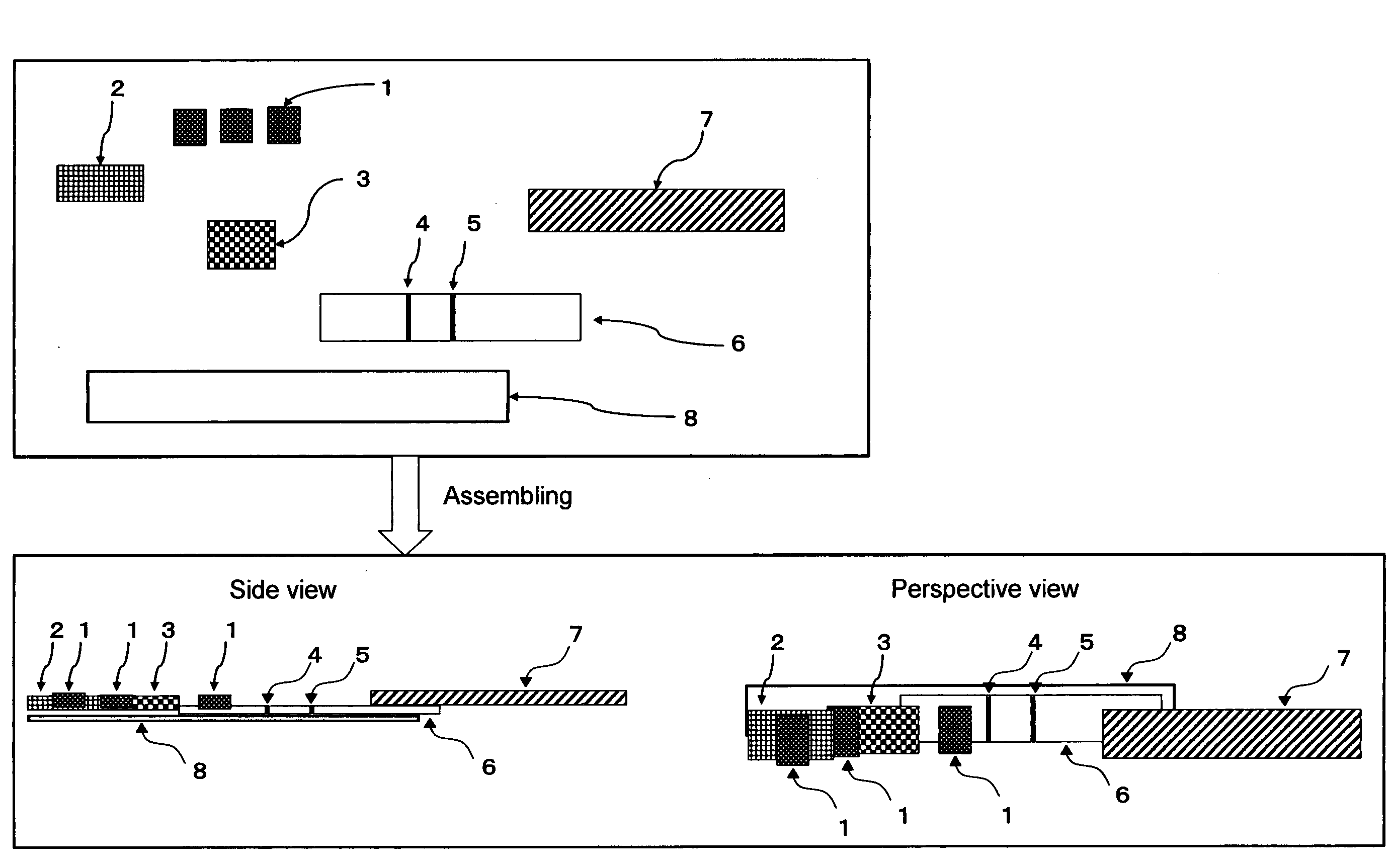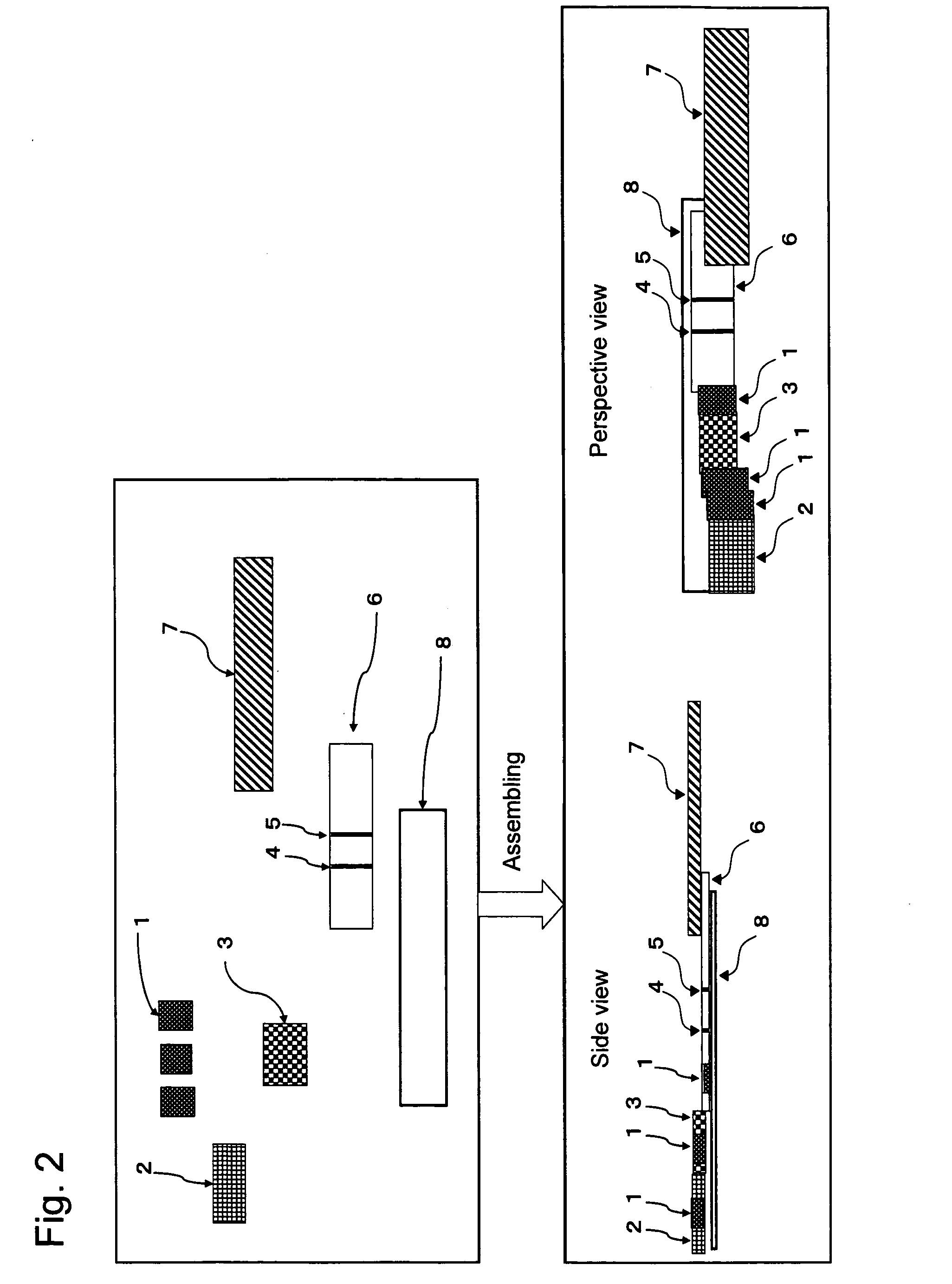Chromatography Detection Apparatus, Detection Method, and Kit Utilizing the Same
a technology of chromatography and detection method, applied in the field of chromatography detection apparatus, can solve the problems of inability to perform pretreatment, and inability to meet the requirements of the sample, so as to achieve the effect of high sensitivity, high sensitivity, and convenient pretreatmen
- Summary
- Abstract
- Description
- Claims
- Application Information
AI Technical Summary
Benefits of technology
Problems solved by technology
Method used
Image
Examples
example 1
Elimination of Nonspecific Reaction of Chondroitin Sulfate in Detection of Influenza A Virus (FIG. 3)
(1) Preparation of Colloidal Gold Antibodies
[0087]Colloidal gold (10 ml) was fractionated, and the pH level was adjusted to 7.0 with the aid of 100 mM potassium carbonate. Anti-influenza A virus monoclonal antibodies were dialyzed with a 2 mM boric acid solution, centrifuged, and purified. A 2 mM boric acid solution was added thereto to prepare a solution containing the antibodies at a concentration of 100 μg / ml. A fraction of the resulting solution containing the anti-influenza A virus monoclonal antibodies at a final concentration of 10 μg / ml was thoroughly agitated and added to the colloidal gold. Five minutes thereafter, 1 ml of 10% BSA was added and the mixture was moderately agitated with a rotator for 10 minutes. The entire amount of the solution was transferred to a centrifugation tube and centrifugation was carried out at 14,000 rpm for 30 minutes at 4° C. After the centrifu...
example 2
Detection of PBP2′ of MRSA (FIG. 5)
(1) Preparation of Colloidal Gold Antibodies
[0094]Colloidal gold (10 ml) was fractionated, and the pH level was adjusted to 8.0 with the addition of 100 mM potassium carbonate. The anti-PBP2′ antibodies were dialyzed with a 2 mM boric acid solution, centrifuged, and purified. A 2 mM boric acid solution was added thereto to prepare a solution containing the antibodies at a concentration of 40 μg / ml. A fraction of the resulting solution containing the anti-PBP2′ antibodies at a final concentration of 2 μg / ml was thoroughly agitated and added to the colloidal gold. Five minutes thereafter, 1 ml of 10% BSA was added and the mixture was moderately agitated with a rotator for 10 minutes. The entire amount of the solution was transferred to a centrifugation tube and centrifugation was carried out at 14,000 rpm for 30 minutes at 4° C. After the centrifugation, the supernatant was suctioned, and 1 ml of a 10 mM borate buffer was added to the colloidal gold ...
example 3
Avoidance of Nonspecific Reaction Caused by Protein A in the Detection of PBP2′ of MRSA (FIG. 8)
(1) Preparation of Colloidal Gold Antibodies
[0101]Colloidal gold (10 ml) was fractionated, and the pH level was adjusted to 8.0 with the addition of 100 mM potassium carbonate. The anti-PBP2′ antibodies were dialyzed with a 2 mM boric acid solution, centrifuged, and purified. A 2 mM boric acid solution was added thereto to prepare a solution containing the antibodies at a concentration of 40 μg / ml. A fraction of the resulting solution containing the anti-PBP2′ antibodies at a final concentration of 2 μg / ml was thoroughly agitated and added to the colloidal gold. Five minutes thereafter, 1 ml of 10% BSA was added and the mixture was moderately agitated with a rotator for 10 minutes. The entire amount of the solution was transferred to a centrifugation tube and centrifugation was carried out at 14,000 rpm for 30 minutes at 4° C. After the centrifugation, the supernatant was suctioned, and 1...
PUM
| Property | Measurement | Unit |
|---|---|---|
| concentration | aaaaa | aaaaa |
| concentration | aaaaa | aaaaa |
| pH | aaaaa | aaaaa |
Abstract
Description
Claims
Application Information
 Login to View More
Login to View More - R&D
- Intellectual Property
- Life Sciences
- Materials
- Tech Scout
- Unparalleled Data Quality
- Higher Quality Content
- 60% Fewer Hallucinations
Browse by: Latest US Patents, China's latest patents, Technical Efficacy Thesaurus, Application Domain, Technology Topic, Popular Technical Reports.
© 2025 PatSnap. All rights reserved.Legal|Privacy policy|Modern Slavery Act Transparency Statement|Sitemap|About US| Contact US: help@patsnap.com



